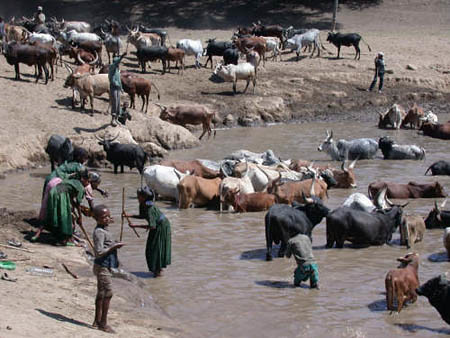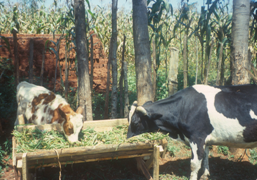Today saw the publication of a special issue of Experimental Agriculture guest edited by Tilahun Amede, Shirley Tarawali and Don Peden. It presents evidence from Ethiopia, Zimbabwe and India, and captures current understanding of strategies to improve water productivity in drought-prone crop-livestock systems.
Crop-livestock systems in sub-Saharan Africa (SSA) are mostly rainfall-dependent and based on fragmented marginal lands that are vulnerable to soil erosion, drought and variable weather conditions. The threat of water scarcity in these systems is real, due to expanding demand for food and feed, climate variability and inappropriate land use.
According to recent estimates, farming, industrial and urban needs in developing countries will increase water demand by 40% by 2030. Water shortage is expected to be severe in areas where the amount of rainfall will decrease due to climate change. The lack of capacity of communities living in drought-prone regions to respond to market opportunities, climatic variability and associated water scarcity also results from very low water storage facilities, poverty and limited institutional capacities to efficiently manage the available water resources at
local, national and basin scales.
The spiral of watershed degradation causes decline in water budgets, decreases soil fertility and reduces farm incomes in SSA and reduces crop and livestock water productivity. In areas where irrigated agriculture is feasible, there is an increasing demand for water and competition among different users and uses.
Strategies and policies to reduce rural poverty should not only target increasing food production but should also emphasize improving water productivity at farm, landscape, sub-basin and higher levels. In drought-prone rural areas, an increase of 1% in crop water productivity makes available at least an extra 24 litres of water a day per person. Moreover, farming systems with efficient use of water resources are commonly responsive to external and internal drivers of change.
Articles included in the issue are:
Amede, T., Tarawali, S. and Peden, D. Improving water productivity in crop livestock systems of drought-prone regions. Editorial Comment
Amede, T., Menza, M. and Awlachew, S. B. Zai improves nutrient and water productivity in the Ethiopian highlands
Descheemaeker, K., Amede, T., Haileslassie, A. and Bossio, D. Analysis of gaps and possible interventions for improving water productivity in crop livestock systems of Ethiopia
Derib, S. D., Descheemaeker, K., Haileslassie, A. and Amede, T. Irrigation water productivity as affected by water management in a small-scale irrigation scheme in the Blue Nile Basin, Ethiopia
Awulachew, S. B. and Ayana, M. Performance of irrigation: an assessment at different scales in Ethiopia
Ali, H., Descheemaeker, K., Steenhuis, T. S. and Pandey, S. Comparison of landuse and landcover changes, drivers and impacts for a moisture-sufficient and drought-prone region in the Ethiopian Highlands
Mekonnen, S., Descheemaeker, K., Tolera, A. and Amede, T. Livestock water productivity in a water stressed environment in Northern Ethiopia
Deneke, T. T., Mapedza, E. and Amede, T. Institutional implications of governance of local common pool resources on livestock water productivity in Ethiopia
Haileslassie, A., Blümmel, M., Clement, F., Descheemaeker, K., Amede, T. Samireddypalle, A., Acharya, N. S., Radha, A. V., Ishaq, S., Samad, M., Murty, M. V. R. and Khan, M. A. Assessment of the livestock-feed and water nexus across a mixed crop-livestock system’s intensification gradient: an example from the Indo-Ganga Basin
Clement, F., Haileslassie, A., Ishaq, S., Blummel, M., Murty, M. V. R., Samad, M., Dey, S., Das, H. and Khan, M. A. Enhancing water productivity for poverty alleviation: role of capitals and institutions in the Ganga Basin
Sibanda, A., Tui, S. H.-K., Van Rooyen, A., Dimes, J., Nkomboni, D. and Sisito, G. Understanding community perceptions of land use changes in the rangelands, Zimbabwe
Senda, T. S., Peden, D., Tui, S. H.-K., Sisito, G., Van Rooyen, A. F. and Sikosana, J. L. N. Gendered livelihood implications for improvements of livestock water productivity in Zimbabwe


 Also called elephant grass, Napier grass is planted on farms across East Africa as a source of feed for dairy cows. Farmers cut the grass for their livestock, carrying it home for stall feeding.
Also called elephant grass, Napier grass is planted on farms across East Africa as a source of feed for dairy cows. Farmers cut the grass for their livestock, carrying it home for stall feeding.